General electric JVM1871, JVM3670, DVM1850, JVM2050, EMO4000 Owner’s Manual
...
|
|
|
|
|
ge.com |
|
Spacemaker |
Safety Instructions |
. . . .2–9 |
Español |
|||
Changing the |
|
|
|
Para consultar una |
||
Oven |
Operating Instructions |
For a Spanish version |
||||
Auto Features |
|
|
20 |
of this manual, |
||
. . . |
. . |
visit our Website at |
||||
Care and |
|
|
|
|||
|
|
|
ge.com. |
|||
Cleaning |
|
|
33, 34 |
|||
. . . |
. . |
|
|
|||
Power Level . . |
. . . |
. . |
. . .13 |
version en español |
||
Cooking Guide |
. . . |
. . |
15, 16 |
de este manual |
||
Defrosting Guide . |
. . |
. . .18 |
de instrucciones, |
|||
Exhaust Feature . . |
. . |
37, 38 |
visite nuestro sitio |
|||
Microwave |
Features of Your |
|
|
de internet ge.com. |
||
Microwave Oven |
|
11, 12 |
|
|
||
|
. . |
|
|
|||
|
Microwave Terms . |
. . |
. . .32 |
|
|
|
|
Other Features |
. . . . 25–31 |
|
|
||
|
Replacing Bulbs |
. . |
. . |
35, 36 |
|
|
|
Sensor Features |
. . . .21–24 |
|
|
||
|
Time Features . |
. . . |
. . |
14–19 |
|
|
|
Troubleshooting Tips |
. . .39 |
|
|
||
|
Things That Are |
|
|
|
|
|
|
Normal With Your |
|
|
|
|
|
|
Microwave Oven . . |
. . |
. . .40 |
|
|
|
|
Consumer Support |
|
|
|
|
|
|
Consumer |
|
|
|
|
|
|
Support . . . . . . |
Back Cover |
|
|
||
|
Optional Kits . |
. . . |
. . |
. . .10 |
|
|
|
Product |
|
|
|
|
|
|
Registration . . |
. . . |
. . |
41, 42 |
|
|
|
Warranty . . . . . |
. . . |
. . |
. . .43 |
|
|
Write the model and serial numbers here:
Model # __________________________
Serial # __________________________
Find these numbers on a label inside the oven.
Owner’s
Manual
JVM1850
JNM1851
JVM1870
JVM1871
JVM2050
JVM3670
DVM1850
EMO4000
DE68-03327A 49-40537 09-06 JR

Safety Instructions
Operating Instructions
Troubleshooting Tips
Consumer Support
IMPORTANT SAFETY INFORMATION. READ ALL INSTRUCTIONS BEFORE USING.
 WARNING!
WARNING!
For your safety, the information in this manual must be followed to minimize the risk of fire or explosion, electric shock, or to prevent property damage, personal injury, or loss of life.
PRECAUTIONS TO AVOID
POSSIBLE EXPOSURE TO
EXCESSIVE MICROWAVE ENERGY
■Do Not Attempt to operate this oven with the door open since open-door operation can result in harmful exposure to microwave energy. It is important not to defeat or tamper with
the safety interlocks.
■Do Not Place any object between the oven front face and the door or allow soil or cleaner residue to accumulate on sealing surfaces.
■ Do Not Operate the oven if it is damaged. It is particularly important that the oven door close properly and that there is no damage to the:
|
door (bent), |
|
1 |
||
|
hinges and latches |
|
2 |
||
(broken or loosened), |
||
|
||
|
door seals and sealing |
|
3 |
||
surfaces. |
||
|
■The Oven Should Not be adjusted or repaired by anyone except properly qualified service personnel.
SAFETY PRECAUTIONS
When using electrical appliances, basic safety precautions should be followed, including the following:
■Read and follow the specific precautions in the Precautions to Avoid Possible Exposure to Excessive Microwave Energy section above.
■This appliance must be grounded. Connect only to a properly grounded outlet. See the Grounding Instructions section on page 8.
2
■Install or locate this appliance only in accordance with the provided Installation Instructions.
■This microwave oven is intended for household use and is UL listed for installation over electric and gas ranges.
■This microwave oven is not approved or tested for marine use.

ge.com
Use this appliance only for its intended purpose as described in this Owner’s Manual.
■Do not mount this appliance over a sink.
■This over-the-range oven was designed for use over ranges no wider than 36″. It may be installed over both gas and electric cooking equipment.
■Do not operate this appliance if it has a damaged power cord or plug, if it is not working properly or if it has been damaged or dropped. If the power cord is damaged, it must be replaced by General Electric Service or an authorized service agent using a power cord available from General Electric.
■Do not cover or block any openings on the appliance.
■Use this appliance only for its intended use as described in this manual. Do not use corrosive chemicals or vapors in this appliance. This microwave oven is specifically designed to heat, dry or cook food, and is not intended for laboratory or industrial use.
■Do not store this appliance outdoors. Do not use this product near water— for example, in a wet basement, near a swimming pool, near a sink or in similar locations.
■Keep power cord away from heated surfaces.
■Do not immerse power cord or plug in water.
■Do not store anything directly on top of the microwave oven surface when the microwave oven is in operation.
■To reduce the risk of fire in the oven cavity:
–Do not overcook food. Carefully attend appliance when paper, plastic or other combustible materials are placed inside the oven while cooking.
–Remove wire twist-ties and metal handles from paper or plastic containers before placing them in the oven.
–Do not use the oven for storage purposes. Do not leave paper products, cooking utensils or food in the oven when not in use.
–If materials inside the oven ignite, keep the oven door closed, turn the oven off and disconnect the power cord, or shut off power at the fuse or circuit breaker panel. If the door is opened, the fire may spread.
–Do not use the Sensor Features twice in succession on the same food portion. If food is undercooked after
the first countdown, use Time Cook for additional cooking time.
■See door surface cleaning instructions in the Care and cleaning of the microwave oven section of this manual.
■This appliance should be serviced only by qualified service personnel. Contact nearest authorized service facility for examination, repair or adjustment.
■As with any appliance, close supervision is necessary when used by children.
Instructions Safety
Instructions Operating
Tips Troubleshooting
Support Consumer
3

Safety Instructions
Operating Instructions
Troubleshooting Tips
Consumer Support
IMPORTANT SAFETY INFORMATION. READ ALL INSTRUCTIONS BEFORE USING.
 WARNING!
WARNING!
ARCING
If you see arcing, press the CLEAR/OFF pad and correct the problem.
Arcing is the microwave term for sparks in the oven. Arcing is caused by:
■The metal shelf not installed correctly so it touches the microwave wall.
■Metal or foil touching the side of the oven.
■Foil not molded to food (upturned edges act like antennas).
■Metal, such as twist-ties, poultry pins or goldrimmed dishes, in the microwave.
■Recycled paper towels containing small metal pieces being used in the microwave.
FOODS
■Do not pop popcorn in your microwave oven unless in a special microwave popcorn accessory or unless you use popcorn labeled for use in microwave ovens.
■Some products such as whole eggs and sealed containers—for example, closed jars—are able to explode and should not be heated in this microwave oven. Such use of the microwave oven could result in injury.
■Do not boil eggs in a microwave oven. Pressure will build up inside egg yolk and will cause it to burst, possibly resulting in injury.
■Operating the microwave with no food inside for more than a minute or two may cause damage to the oven and could start a fire. It increases the heat around the magnetron and can shorten the life of the oven.
■Foods with unbroken outer “skin” such as potatoes, hot dogs, sausages, tomatoes, apples, chicken livers and other giblets, and egg yolks should be pierced to allow steam to escape during cooking.
4

ge.com
■SUPERHEATED WATER
Liquids, such as water, coffee or tea are able to be overheated beyond the boiling point without appearing to be boiling. Visible bubbling or boiling when the container is removed from the microwave oven is not always present. THIS COULD RESULT IN VERY HOT LIQUIDS SUDDENLY BOILING OVER WHEN THE CONTAINER IS DISTURBED OR A SPOON OR OTHER UTENSIL IS INSERTED INTO THE LIQUID.
To reduce the risk of injury to persons:
—Do not overheat the liquid.
—Stir the liquid both before and halfway through heating it.
—Do not use straight-sided containers with narrow necks.
—After heating, allow the container to stand in the microwave oven for a short time before removing the container.
—Use extreme care when inserting a spoon or other utensil into the container.
■Avoid heating baby food in glass jars, even with the lid off. Make sure all infant food is thoroughly cooked. Stir food to distribute the heat evenly. Be careful to prevent scalding when warming formula or breast milk. The container may feel cooler than the milk really is. Always test the milk before feeding the baby.
■Don’t defrost frozen beverages in narrow-necked bottles (especially carbonated beverages). Even if the container is opened, pressure can build up. This can cause the container to burst, possibly resulting in injury.
■Hot foods and steam can cause burns. Be careful when opening any containers of hot food, including popcorn bags, cooking pouches and boxes. To prevent possible injury, direct steam away from hands and face.
■Do not overcook potatoes. They could dehydrate and catch fire, causing damage to your oven.
■Cook meat and poultry thoroughly—meat to at least an INTERNAL temperature of 160°F and poultry to at least an INTERNAL temperature
of 180°F. Cooking to these temperatures usually protects against foodborne illness.
Instructions Safety
Instructions Operating
Tips Troubleshooting
Support Consumer
5

Safety Instructions
Operating Instructions
Troubleshooting Tips
Consumer Support
IMPORTANT SAFETY INFORMATION. READ ALL INSTRUCTIONS BEFORE USING.
 WARNING!
WARNING!
MICROWAVE-SAFE COOKWARE
Make sure all cookware used in your microwave oven is suitable for microwaving. Most glass casseroles, cooking dishes, measuring cups, custard cups, pottery or china dinnerware which does not have metallic trim or glaze with a metallic sheen can be used. Some cookware is labeled “suitable for microwaving.”
How to test for a microwavesafe dish.
■If you are not sure if a dish is microwave-safe, use this test: Place in the oven both the dish you are testing and a glass measuring cup filled with 1 cup of water—set the measuring cup either in or next to the dish. Microwave 30–45 seconds at high. If the dish heats, it should not be used for microwaving.
If the dish remains cool and only the water in the cup heats, then the dish is microwave-safe.
■If you use a meat thermometer while cooking, make sure it is safe for use in microwave ovens.
■Do not use recycled paper products. Recycled paper towels, napkins and waxed paper can contain metal flecks which may cause arcing or ignite. Paper products containing nylon or nylon filaments should be avoided, as they may also ignite.
■Some styrofoam trays (like those that meat is packaged on) have a thin strip of metal embedded in the bottom. When microwaved, the metal can burn the floor of the oven or ignite a paper towel.
■Do not use the microwave to dry newspapers.
■Not all plastic wrap is suitable for use in microwave ovens. Check the package for proper use.
■Paper towels, waxed paper and plastic wrap can be used to cover dishes in order to retain moisture and prevent spattering.
Be sure to vent plastic wrap so steam can escape.
■Cookware may become hot because of heat transferred from the heated food. Pot holders may be needed to handle the cookware.
6

ge.com
■“Boilable” cooking pouches and tightly closed plastic bags should be slit, pierced or vented as directed by package. If they are not, plastic could burst during or immediately after cooking, possibly resulting in injury. Also, plastic storage containers should be at least partially uncovered because they form a tight seal. When cooking with containers tightly covered with plastic wrap, remove covering carefully and direct steam away from hands and face.
■Use foil only as directed
in this manual. When using
foil in the microwave oven, keep the foil at least 1″ away from the sides of the oven.
■Plastic cookware – Plastic cookware designed for microwave cooking is very useful, but should be used carefully. Even microwavesafe plastic may not be as tolerant of overcooking conditions as are glass or ceramic materials and may soften or char if subjected to short periods of overcooking. In longer exposures to overcooking, the food and cookware could ignite.
Follow these guidelines:
1Use microwave-safe plastics only and use them in strict compliance with the cookware manufacturer’s recommendations.
2 Do not microwave empty containers.
3 Do not permit children to use plastic cookware without complete supervision.
Instructions Safety
Instructions Operating
Tips Troubleshooting
Support Consumer
7

Safety Instructions
Operating Instructions
Troubleshooting Tips
Consumer Support
IMPORTANT SAFETY INFORMATION. READ ALL INSTRUCTIONS BEFORE USING.
 WARNING!
WARNING!
Improper use of the grounding plug can result in a risk of electric shock.
GROUNDING INSTRUCTIONS
This appliance must be grounded. In the event of an electrical short circuit, grounding reduces the risk of electric shock by providing an escape wire for the electric current.
This appliance is equipped with a power cord having a grounding wire with a grounding plug. The
plug must be plugged into an outlet that is properly installed and grounded.
Consult a qualified electrician or service technician if the grounding instructions are not completely understood, or if doubt exists as to whether the appliance is properly grounded.
If the outlet is a standard 2-prong wall outlet, it is your personal responsibility and obligation to have it replaced with a properly grounded 3-prong wall outlet.
Do not under any circumstances cut or remove the third (ground) prong from the power cord.
Do not use an adapter plug with this appliance.
Do not use an extension cord with this appliance. If the power cord is too short, have a qualified electrician or service technician install an outlet near the appliance.
For best operation, plug this appliance into its own electrical outlet to prevent flickering of lights, blowing of fuse or tripping of circuit breaker.
8

ge.com
THE VENT FAN
The fan will operate automatically under certain conditions (see Automatic Fan feature). Take care to prevent the starting and spreading of accidental cooking fires while the vent fan is in use.
■Clean the underside of the microwave often. Do not allow grease to build up on the microwave or the fan filter.
■In the event of a grease fire on the surface units below the microwave oven, smother a flaming pan on the surface unit by covering the pan completely with a lid, a cookie sheet or a flat tray.
■Use care when cleaning the vent fan filter. Corrosive cleaning agents, such as lye-based oven cleaners, may damage the filter.
■When preparing flaming foods under the microwave, turn the fan on.
■Never leave surface units beneath your microwave oven unattended at high heat settings. Boilovers cause smoking and greasy spillovers that may ignite and spread if the microwave vent fan is operating. To minimize automatic fan operation, use adequate-sized cookware and use high heat on surface units only when necessary.
READ AND FOLLOW THIS SAFETY INFORMATION CAREFULLY.
SAVE THESE INSTRUCTIONS
Instructions Safety
Instructions Operating
Tips Troubleshooting
Support Consumer
9

Safety Instructions
Operating Instructions
Troubleshooting Tips
Consumer Support
About optional kits.
OPTIONAL KITS
Filler Panel Kits |
JX81B, JX81H |
JX52WH – White |
|
JX52BL – Black |
|
When replacing a 36″ range |
|
hood, filler panel kits fill in |
|
the additional width to |
|
provide a custom built-in |
|
appearance. |
JX52 |
|
For installation between cabinets
only; not for end-of-cabinet installation. Each kit contains two 3″-wide filler panels.
Filter Kits
JX81B – Recirculating Charcoal Filter Kit (1800 and 3600 Series models)
JX81H – Recirculating Charcoal Filter Kit (2000 Series models)
Filter kits are used when the microwave oven cannot be vented to the outside.
Available at extra cost from your GE supplier. See the back cover for ordering by phone or at ge.com.
10
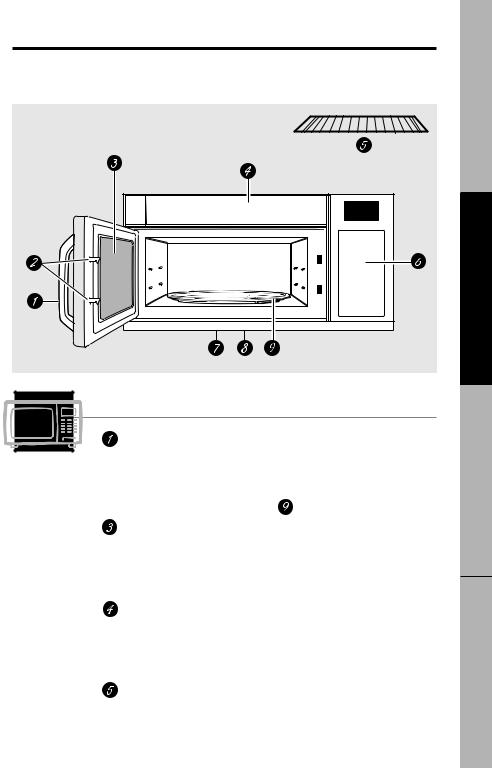
About the features of your |
|
microwave oven. |
ge.com |
Throughout this manual, features and appearance may vary from your model.
Features of the Oven
Door Handle. Pull to open the door. The door must be securely latched for the microwave to operate.
 Door Latches.
Door Latches.
Window with Metal Shield.
Screen allows cooking to be viewed while keeping microwaves confined in the oven.
Active Vent (on some models). The vent door swings open when the fan operates and closes when the fan shuts off.
Shelf. Lets you microwave several foods at once. Food microwaves best when placed directly on the turntable.
 Touch Control Panel Display.
Touch Control Panel Display.
 Cooktop Light.
Cooktop Light.
 Grease Filter.
Grease Filter.
Removable Turntable.
Turntable and support must be in place when using the oven. The turntable may be removed for cleaning.
NOTE: Rating plate is located on the inside wall of the microwave, or on the upper left front behind the door. Oven vent(s) and oven light are located on the inside walls of the microwave oven.
Instructions Safety
Instructions Operating
Tips Troubleshooting
Support Consumer
11
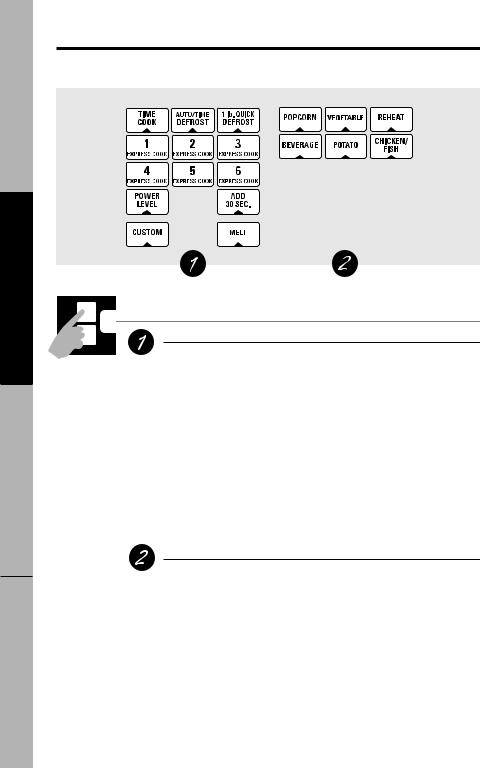
Safety Instructions
Operating Instructions
Troubleshooting Tips
Consumer Support
About the features of your microwave oven.
You can microwave by time, with the sensor features or with the auto features.
Cooking Controls
Time and Auto Features
Press |
Enter |
TIME COOK I & II |
Amount of cooking time |
Press once or twice |
|
AUTO/TIME DEFROST |
Amount of defrosting time |
Press twice |
|
CUSTOM (on some models) |
Follow displayed instructions |
EXPRESS COOK |
Starts immediately! |
ADD 30 SEC |
Starts immediately! |
POWER LEVEL |
Power level 1–10 |
AUTO/TIME DEFROST |
Food weight |
Press once |
up to 6 lbs. |
1 lb. QUICK DEFROST |
Starts immediately! |
MELT (on some models) |
Food type |
Press |
Enter |
Option |
POPCORN |
Starts immediately! |
more/less time |
BEVERAGE |
Starts immediately! |
|
REHEAT |
Starts immediately! |
|
Press once (plate of 3 foods) |
|
more/less time |
Press twice (pasta 8–12 oz.) |
|
more/less time |
Press three times (vegetables 1/2–2 cups) |
|
more/less time |
POTATO |
Starts immediately! |
more/less time |
VEGETABLE |
Starts immediately! |
|
Press once (fresh vegetables) |
|
more/less time |
Press twice (frozen vegetables) |
|
more/less time |
Press three times (canned vegetables) |
|
more/less time |
|
|
(on some models) |
CHICKEN/FISH (on some models) |
Starts immediately! |
more/less time |
Press once (chicken pieces) |
|
|
Sensor Features |
|
|
12 |
Press twice (fish) |
|
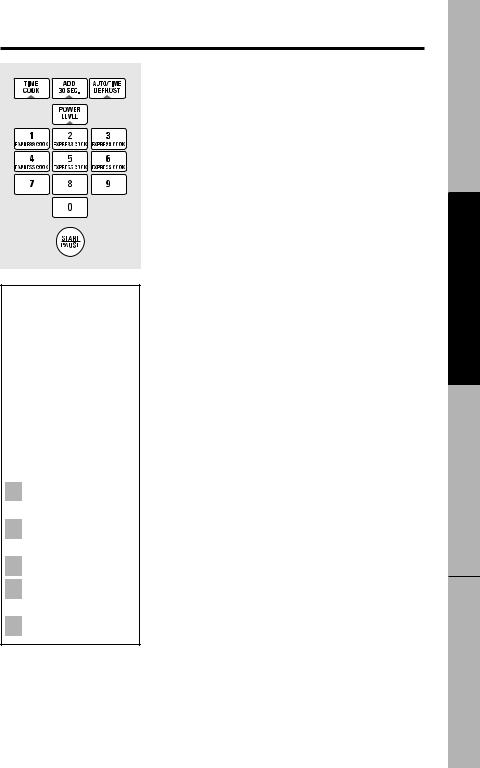
About changing the |
|
power level. |
ge.com |
How to Change the
Power Level
The power level may be entered or changed immediately after entering the feature time for TIME COOK,
TIME DEFROST, EXPRESS COOK or ADD 30 SEC. The power level may also be changed during time countdown.
1 Press TIME COOK or select Time Defrost.
2 Enter cooking or defrosting time.
3 Press POWER LEVEL.
4 Select desired power level 1–10.
5 Press START.
Variable power levels add flexibility to microwave cooking. The power levels on the microwave oven can be compared to the surface units on a range. High (power level 10) or full power is the fastest way to cook and gives you 100% power. Each power level gives you microwave energy a certain percent of the time. Power level 7 is microwave energy 70% of the time. Power level 3 is energy 30% of the time.
A high setting (10) will cook faster but food may need more frequent stirring, rotating or turning over. Most cooking will be done on High (power level 10). A lower setting will cook more evenly and need less stirring or rotating of the food.
Some foods may have better flavor, texture or appearance if one of the lower settings is used. Use a lower power level when cooking foods that have a tendency to boil over, such as scalloped potatoes.
Rest periods (when the microwave energy cycles off) give time for the food to “equalize” or transfer heat to the inside of the food. An example of this is shown with power level 3—the defrost cycle. If microwave energy did not cycle off, the outside of the food would cook before the inside was defrosted.
Here are some examples of uses for various power levels:
Power Level |
Best Uses |
High 10 |
Fish, bacon, vegetables, boiling |
|
liquids. |
Med-High 7 |
Gentle cooking of meat and poultry; |
|
baking casseroles and reheating. |
Medium 5 |
Slow cooking and tenderizing such |
|
as stews and less tender cuts of meat. |
Low 2 or 3 |
Defrosting without cooking; |
|
simmering; delicate sauces. |
Warm 1 |
Keeping food warm without |
|
overcooking; softening butter. |
Instructions Safety
Instructions Operating
Tips Troubleshooting
Support Consumer
13
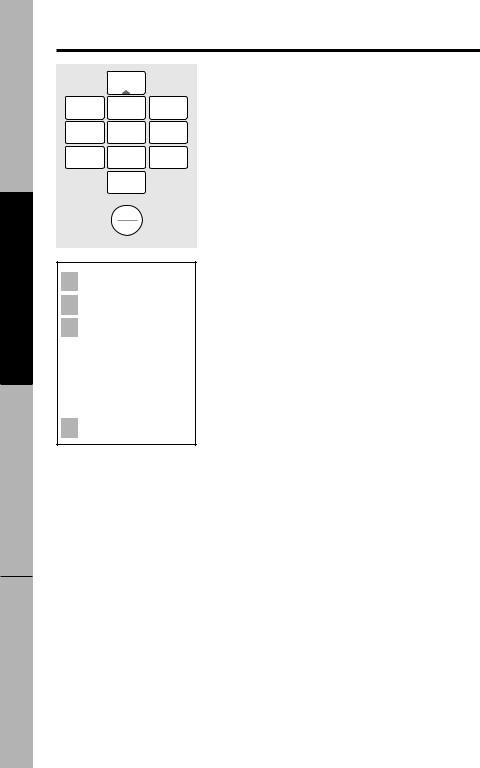
Safety Instructions
Operating Instructions
Troubleshooting Tips
Consumer Support
About the time features.
TIME
COOK
1 |
2 |
3 |
EXPRESS COOK EXPRESS COOK EXPRESS COOK
4 |
5 |
6 |
EXPRESS COOK EXPRESS COOK EXPRESS COOK
7 8 9
0
START
PAUSE
1 Press TIME COOK.
2 Enter cooking time.
3 Change power level if you don’t want full power. (Press
POWER LEVEL.
Select a desired power level 1–10.)
4 Press START.
Time Cook I
Allows you to microwave for any time up to 99 minutes and 99 seconds.
Power level 10 (High) is automatically set, but you may change it for more flexibility.
You may open the door during TIME COOK to check the food. Close the door and press START to resume cooking.
Time Cook II
Lets you change power levels automatically during cooking. Here’s how to do it:
|
Press TIME COOK. |
|
1 |
||
|
Enter the first cook time. |
|
2 |
||
|
Change the power level if you don’t want full |
|
3 |
||
power. (Press POWER LEVEL. Select a desired |
||
|
||
|
power level 1–10.) |
|
|
Press TIME COOK again. |
|
4 |
||
|
Enter the second cook time. |
|
5 |
||
|
Change the power level if you don’t want full |
|
6 |
||
power. (Press POWER LEVEL. Select a power |
||
|
||
|
level 1–10.) |
|
|
Press START. |
|
7 |
At the end of Time Cook I, Time Cook II counts down.
14

ge.com
Cooking Guide for Time Cook I and Time Cook II
NOTE: Use power level High (10) unless otherwise noted.
Vegetable |
Amount |
Time |
Comments |
Asparagus |
|
|
|
(fresh spears) |
1 lb. |
6 to 9 min., |
In 11⁄2-qt. oblong glass baking |
|
|
Med-High (7) |
dish, place 1/4 cup water. |
(frozen spears) |
10-oz package |
5 to 7 min. |
In 1-qt. casserole. |
|
|
|
|
Beans |
|
|
|
(fresh green) |
1 lb. cut in half |
9 to 11 min. |
In 11⁄2-qt. casserole, place |
|
|
|
1/2 cup water. |
(frozen green) |
10-oz package |
6 to 8 min. |
In 1-qt. casserole, place |
|
|
|
2 tablespoons water. |
(frozen lima) |
10-oz package |
6 to 8 min. |
In 1-qt. casserole, place |
|
|
|
1/4 cup water. |
|
|
|
|
Beets |
|
|
|
(fresh, whole) |
1 bunch |
17 to 21 min. In 2-qt. casserole, place |
|
|
|
|
1/2 cup water. |
|
|
|
|
Broccoli |
|
|
|
(fresh cut) |
1 bunch |
7 to 10 min. |
In 2-qt. casserole, place |
|
(11⁄4 to 11⁄2 lbs.) |
|
1/2 cup water. |
(fresh spears) |
1 bunch |
9 to 13 min. |
In 2-qt. oblong glass baking |
|
(11⁄4 to 11⁄2 lbs.) |
|
dish, place 1/4 cup water. |
(frozen, |
10-oz package |
5 to 7 min. |
In 1-qt. casserole. |
chopped) |
|
|
|
(frozen spears) |
10-oz package |
5 to 7 min. |
In 1-qt. casserole, place |
|
|
|
3 tablespoons water. |
|
|
|
|
Cabbage |
|
|
|
(fresh) |
1 medium head |
8 to 11 min. |
In 11⁄2- or 2-qt. casserole, place |
|
(about 2 lbs.) |
|
1/4 cup water. |
(wedges) |
|
7 to 10 min. |
In 2- or 3-qt. casserole, place |
|
|
|
1/4 cup water. |
Carrots |
|
|
|
(fresh, sliced) |
1 lb. |
7 to 9 min. |
In 11⁄2-qt. casserole, place |
|
|
|
1/4 cup water. |
(frozen) |
10-oz package |
5 to 7 min. |
In 1-qt. casserole, place |
|
|
|
2 tablespoons water. |
|
|
|
|
Cauliflower |
|
|
|
(flowerets) |
1 medium head |
9 to 14 min. |
In 2-qt. casserole, place |
|
|
|
1/2 cup water. |
(fresh, whole) |
1 medium head |
10 to 17 min. In 2-qt. casserole, place |
|
|
|
|
1/2 cup water. |
(frozen) |
10-oz package |
5 to 7 min. |
In 1-qt. casserole, place |
|
|
|
2 tablespoons water. |
Instructions Safety
Instructions Operating
Tips Troubleshooting
Support Consumer
15

Safety Instructions
Operating Instructions
Troubleshooting Tips
Consumer Support
About the time features.
Vegetable |
Amount |
Time |
Comments |
Corn |
|
|
|
(frozen kernel) |
10-oz package |
5 to 7 min. |
In 1-qt. casserole, place |
|
|
|
2 tablespoons water. |
|
|
|
|
Corn on the cob |
|
|
|
(fresh) |
1 to 5 ears |
3 to 4 min. |
In 2-qt. oblong glass baking |
|
|
per ear |
dish, place corn. If corn is in |
|
|
|
husk, use no water; if corn has |
|
|
|
been husked, add 1/4 cup |
|
|
|
water. Rearrange after half |
|
|
|
of time. |
(frozen) |
1 ear |
5 to 6 min. |
Place in 2-qt. oblong glass |
|
|
|
baking dish. |
|
2 to 6 ears |
3 to 4 min. |
Cover with vented plastic wrap. |
|
|
per ear |
Rearrange after half of time. |
Mixed |
|
|
|
vegetables |
|
|
|
(frozen) |
10-oz package |
5 to 7 min. |
In 1-qt. casserole, place |
|
|
|
3 tablespoons water. |
|
|
|
|
Peas |
|
|
|
(fresh, shelled) |
2 lbs. unshelled |
9 to 12 min. |
In 1-qt. casserole, place |
|
|
|
1/4 cup water. |
(frozen) |
10-oz package |
5 to 7 min. |
In 1-qt. casserole, place |
|
|
|
2 tablespoons water. |
|
|
|
|
Potatoes |
|
|
|
(fresh, cubed, |
4 potatoes |
9 to 12 min. |
Peel and cut into 1 inch cubes. |
white) |
(6 to 8 oz each) |
|
Place in 2-qt. casserole with |
|
|
|
1/2 cup water. Stir after half |
|
|
|
of time. |
(fresh, whole, |
1 (6 to 8 oz) |
3 to 4 min. |
Pierce with cooking fork. |
sweet or white) |
|
|
Place in center of the oven. |
|
|
|
Let stand 5 minutes. |
Spinach |
|
|
|
(fresh) |
10 to 16 oz |
5 to 7 min. |
In 2-qt. casserole, place washed |
|
|
|
spinach. |
(frozen, |
10-oz package |
5 to 7 min. |
In 1-qt. casserole, place |
chopped |
|
|
3 tablespoons water. |
and leaf) |
|
|
|
|
|
|
|
Squash |
|
|
|
(fresh, summer |
1 lb. sliced |
5 to 7 min. |
In 11⁄2-qt. casserole, place |
and yellow) |
|
|
1/4 cup water. |
(winter, acorn, |
1 to 2 squash |
8 to 11 min. |
Cut in half and remove fibrous |
butternut) |
(about 1 lb. each) |
|
membranes. In 2-qt. oblong |
|
|
|
glass baking dish, place squash |
|
|
|
cut-side-down. Turn cut-side-up |
|
|
|
after 4 minutes. |
16

ge.com
Time Defrost
Allows you to defrost for the length of time you select. See the Defrosting Guide for suggested times.
Power level 3 is automatically set, but you may change this for more flexibility. You may defrost small items more quickly by raising the power level after entering the time. However, they will need more frequent attention than usual.
Power level 7 cuts the total defrosting time in
about half; power level 10 cuts the total time to approximately 1/3. Rotate or stir food frequently.
A dull thumping noise may be heard during defrosting. This sound is normal when the oven is not operating at High power.
Defrosting Tips
■For best results, place food directly on the defrost rack and place the rack on the turntable.
■Foods frozen in paper or plastic can be defrosted in the package. Tightly closed packages should be slit, pierced or vented AFTER food has partially defrosted. Plastic storage containers should be at least partially uncovered.
■Family-size, prepackaged frozen dinners can be defrosted and microwaved. If the food is in a foil container, transfer it to a microwave-safe dish.
■Foods that spoil easily, such as milk, eggs, fish, stuffings, poultry and pork should not be
allowed to sit out for more than one hour after defrosting. Room temperature promotes the growth of harmful bacteria.
■For more even defrosting of larger foods, such as beef, lamb and veal roasts, use Auto Defrost.
■Be sure large meats are completely defrosted before cooking.
■When defrosted, food should be cool but softened in all areas. If still slightly icy, return to the microwave very briefly, or let it stand a few minutes.
Instructions Safety
Instructions Operating
Tips Troubleshooting
Support Consumer
17

Safety Instructions
Operating Instructions
Troubleshooting Tips
Consumer Support
About the time features.
Defrosting Guide
|
Food |
Time |
Comments |
|
Breads, Cakes |
|
|
|
Bread, buns or rolls (1 piece) |
1 min. |
|
|
Sweet rolls (approx. 12 oz) |
3 to 5 min. |
|
|
Fish and Seafood |
|
|
|
Fillets, frozen (1 lb.) |
6 to 8 min. |
|
|
Shellfish, small pieces (1 lb.) |
5 to 7 min. |
Place block in casserole. Turn over |
|
|
|
and break up after half the time. |
|
Fruit |
|
|
|
Plastic pouch – 1 to 2 |
3 to 6 min. |
|
|
(10-oz package) |
|
|
|
Meat |
|
|
|
Bacon (1 lb.) |
2 to 5 min. |
Place unopened package in oven. |
|
|
|
Let stand 5 minutes after defrosting. |
|
Franks (1 lb.) |
2 to 5 min. |
Place unopened package in oven. |
|
|
|
Microwave just until franks can be |
|
|
|
separated. Let stand 5 minutes, if |
|
|
|
necessary, to complete defrosting. |
|
Ground meat (1 lb.) |
5 to 7 min. |
Turn meat over after half the time. |
|
Roast: beef, lamb, veal, pork |
12 to 16 min. |
Use power level 1. |
|
|
per lb. |
|
|
Steaks, chops and cutlets |
5 to 7 min. |
Place unwrapped meat in cooking |
|
|
per lb. |
dish. Turn over after half the time |
|
|
|
and shield warm areas with foil. |
|
|
|
When finished, separate pieces and |
|
|
|
let stand to complete defrosting. |
|
Poultry |
|
|
|
Chicken, broiler-fryer |
15 to 19 min. |
Place wrapped chicken in dish. |
|
cut up (21⁄2 to 3 lbs.) |
|
Unwrap and turn over after |
|
|
|
half the time. When finished, |
|
|
|
separate pieces and microwave |
|
|
|
2 to 4 minutes more, if necessary. |
|
|
|
Let stand to finish defrosting. |
|
Chicken, whole |
17 to 21 min. |
Place wrapped chicken in dish. |
|
(21⁄2 to 3 lbs.) |
|
After half the time, unwrap and |
|
|
|
turn chicken over. Shield warm |
|
|
|
areas with foil. Finish defrosting. |
|
|
|
If necessary, run cold water in the |
|
|
|
cavity until giblets can be removed. |
|
Cornish hen |
7 to 13 min. |
Place unwrapped hen in the oven |
|
|
per lb. |
breast-side-up. Turn over after half |
|
|
|
the time. Run cool water in the |
|
|
|
cavity until giblets can be removed. |
|
Turkey breast (4 to 6 lbs.) |
5 to 9 min. |
Place unwrapped breast in dish |
|
|
per lb. |
breast-side-down. After half the |
|
|
|
time, turn over and shield warm |
|
|
|
areas with foil. Finish defrosting. |
|
|
|
Let stand 1 to 2 hours in refrigerator |
18 |
|
|
to complete defrosting. |
|
|
|

ge.com
1 |
2 |
3 |
EXPRESS COOK EXPRESS COOK EXPRESS COOK
4 |
5 |
6 |
EXPRESS COOK EXPRESS COOK EXPRESS COOK
Express Cook
This is a quick way to set cooking time for 1–6 minutes.
Press one of the Express Cook pads (from 1 to 6) for 1 to 6 minutes of cooking at power level 10. For example, press the 2 pad for 2 minutes of cooking time.
The power level can be changed as time is counting down. Press POWER LEVEL and enter 1–10.
Add 30 Seconds
ADD
30 SEC.
You can use this feature two ways:
■It will add 30 seconds to the time counting down each time the pad is pressed.
■It can be used as a quick way to set 30 seconds of cooking time.
Instructions Safety
Instructions Operating
Tips Troubleshooting
Support Consumer
19
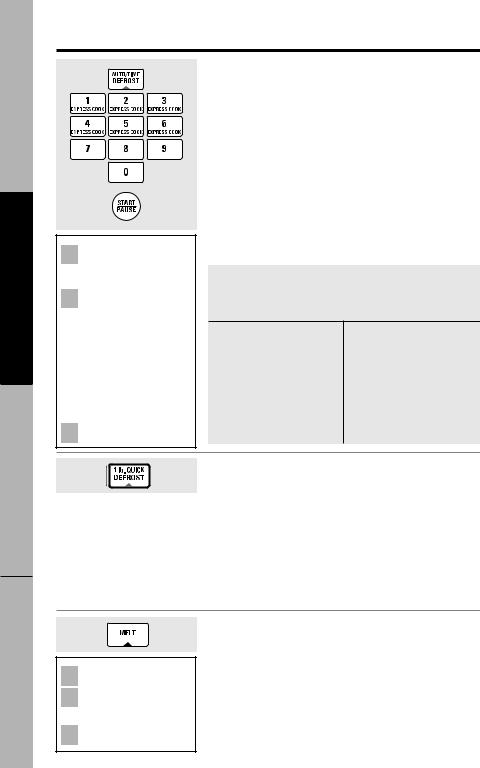
Safety Instructions
Operating Instructions
Troubleshooting Tips
Consumer Support
About the auto features.
1 Press AUTO/TIME DEFROST once for Auto Defrost.
2 Using the Conversion Guide at right, enter food weight. For example, press pads 1 and 2 for 1.2 pounds
(1 pound, 3 ounces). Enter weight up to
6 pounds for Auto Defrost.
3 Press START.
Auto Defrost
Auto Defrost automatically sets the defrosting times and power levels to give even defrosting results for meats, poultry and fish weighing up to six pounds.
■For best results, remove food from the package, place food directly on the defrost rack and place the rack on the turntable.
■Twice during Auto Defrost, the oven signals Turn Food Over. At each signal, turn the food over. Remove defrosted meat or shield warm areas with small pieces of foil.
■After defrosting, most meats need to stand
5 minutes to complete defrosting. Large roasts should stand for about 30 minutes.
Conversion Guide
If the weight of food is stated in pounds and ounces, the ounces must be converted to tenths (.1) of a pound.
Weight of |
Enter Food |
Food in |
Weight |
Ounces |
(tenths of |
|
a pound) |
1–2 |
.1 |
3 |
.2 |
4–5 |
.3 |
6–7 |
.4 |
8 |
.5 |
Weight of |
Enter Food |
Food in |
Weight |
Ounces |
(tenths of |
|
a pound) |
9–10 |
.6 |
11 |
.7 |
12–13 |
.8 |
14–15 |
.9 |
1 lb. Quick Defrost
1 lb. Quick Defrost automatically sets the defrosting times and power levels for foods weighing one pound.
Press 1 lb. Quick Defrost. The oven starts automatically. When the oven signals, turn food over.
■For best results, remove food from the package, place food directly on the defrost rack and place the rack on the turntable.
1
2
3
Press MELT.
Enter number for food type.
Press START.
Melt (on some models)
A convenient way to melt frequently used food items.
Food Item |
Quantity |
Enter |
Butter |
2, 4 or 8 oz |
1 |
Chocolate Chips |
2–16 oz |
2 |
Marshmallow |
2–16 oz |
3 |
Caramel |
2–16 oz |
4 |
Cheese |
2–32 oz |
5 |
|
|
|
20
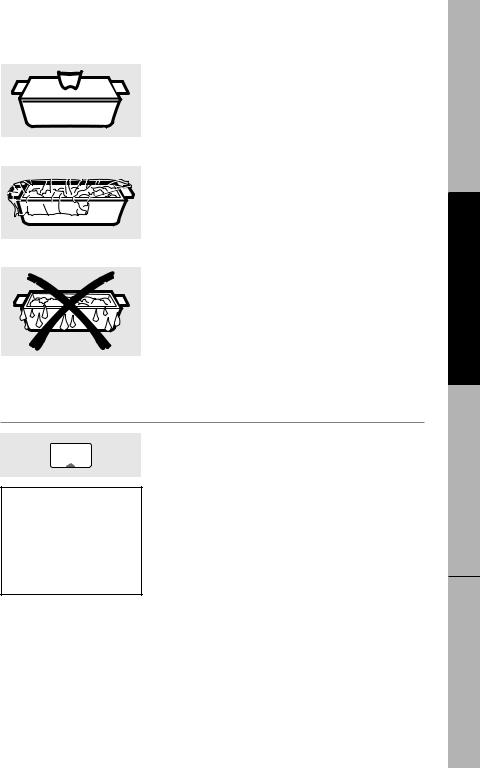
About the sensor features. |
ge.com |
Covered
Vented
Dry off dishes so they don’t mislead the sensor.
Humidity Sensor
What happens when using the Sensor Features:
The Sensor Features detect the increasing humidity released during cooking. The oven automatically adjusts the cooking time to various types and amounts of food.
Do not use the Sensor Features twice in succession on the same food portion—it may result in severely overcooked or burnt food. If food is undercooked after the countdown, use Time Cook for additional cooking time.
The proper containers and covers are essential for best sensor cooking.
Always use microwave-safe containers and cover them with lids or vented plastic wrap. Never use tight sealing plastic containers—they can prevent steam from escaping and cause food to overcook.
Be sure the outside of the cooking containers and the inside of the microwave oven are dry before placing food in the oven. Beads of moisture turning into steam can mislead the sensor.
BEVERAGE
NOTE: Do not use this feature twice in
succession on the same food portion—it may result in severely overcooked or
burnt food.
Beverage
Press BEVERAGE once to heat an 8–10 oz cup of coffee or other beverage.
Drinks heated with the Beverage feature may be very hot. Remove the container with care.
If food is undercooked after the countdown use Time Cook for additional cooking time.
Instructions Safety
Instructions Operating
Tips Troubleshooting
Support Consumer
21

Safety Instructions
Operating Instructions
Troubleshooting Tips
Consumer Support
About the sensor features.
POPCORN
1 9
EXPRESS COOK
Use only with prepackaged microwave popcorn weighing 3.0 to 3.5 ounces.
NOTE: Do not use the metal shelf when using the Popcorn feature.
NOTE: Do not use this feature twice in succession on the same food portion—it may result in severely overcooked or burnt food.
Popcorn
How to Use the Popcorn Feature
1 Follow package instructions, using Time Cook if the package is less than 3.0 ounces or larger than 3.5 ounces. Place the package of popcorn in the center of the microwave.
2 Press POPCORN for a regular size (3.0 to 3.5 oz) bag of popcorn. The oven starts immediately.
If you open the door while POPCORN is displayed, an error message will appear. Close the door and press START.
If food is undercooked after the countdown use Time Cook for additional cooking time.
How to Adjust the Popcorn Program to Provide a Shorter or Longer Cook Time
If you find that the brand of popcorn you use underpops or overcooks consistently, you can add or subtract 20–30 seconds to the automatic popping time.
To add time:
After pressing POPCORN, press 9 within the first 30 seconds after the oven starts for an extra
20 seconds.
Press 9 again to add another 10 seconds (total 30 seconds additional time).
To subtract time:
After pressing POPCORN, press 1 within the first 30 seconds after the oven starts for 20 seconds less cooking time.
Press 1 again to reduce cooking time another 10 seconds (total 30 seconds less time).
22

ge.com
For reheating single servings of previously cooked foods or a plate of leftovers.
NOTE: Do not use the metal shelf when using the Reheat feature.
NOTE: Do not use this feature twice in succession on the same food portion—it may result in severely overcooked or
burnt food.
Reheat
How to Use the Reheat feature:
1 Place the cup of liquid or covered food in the oven. Press REHEAT once, twice or three times. The oven starts immediately.
Press once for a plate of leftovers. Press twice for pasta (8–12 oz).
Press three times for vegetables (1/2 to 2 cups).
2 The oven signals when steam is sensed and the time remaining begins counting down.
Do not open the oven door until time is counting down. If the door is opened, close it and press START immediately.
After removing food from the oven, stir, if possible, to even out the temperature. Reheated foods may have wide variations in temperature. Some areas may be extremely hot.
If food is not hot enough after the countdown use Time Cook for additional reheating time.
How to Change the Automatic Settings:
To reduce time by 10%:
Press 1 within 30 seconds after pressing the
REHEAT pad.
To add 10% to cooking time:
Press 9 within 30 seconds after pressing the
REHEAT pad.
Some Foods Not Recommended For Use With Reheat:
It is best to use Time Cook for these foods:
■Bread products.
■Foods that must be reheated uncovered.
■Foods that need to be stirred or rotated.
■Foods calling for a dry look or crisp surface after reheating.
Instructions Safety
Instructions Operating
Tips Troubleshooting
Support Consumer
23
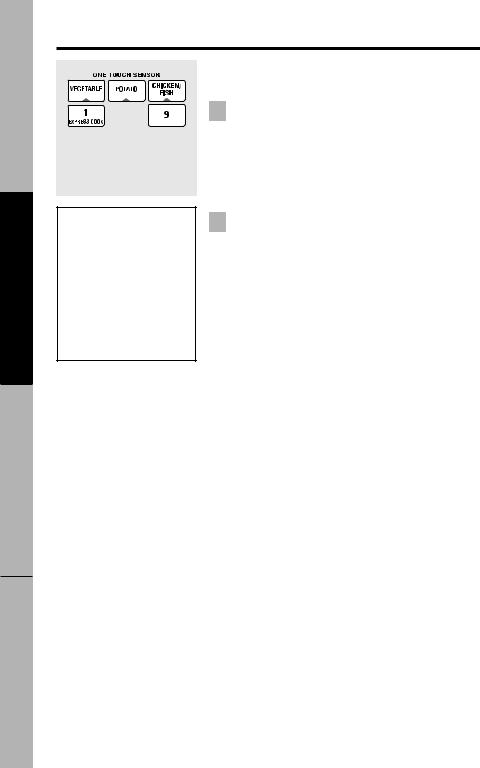
Safety Instructions
Operating Instructions
Troubleshooting Tips
Consumer Support
About the sensor features.
Sensor Cooking
Sensor cooking gives you easy, automatic results with a variety of foods (see the Cooking Guide below).
NOTE: Do not use the metal shelf with Sensor Cooking.
NOTE: Do not use this feature twice in succession on the same food portion—it may result in severely overcooked or
burnt food.
(Fish and Chicken Pieces on some models)
1 Place covered food in the oven. Press the food pad. For vegetables, press the VEGETABLE pad once for fresh vegetables, twice for frozen vegetables or three times for canned vegetables. For chicken or fish, press the CHICKEN/FISH pad once for chicken pieces or twice for fish. The oven starts immediately.
2 The oven signals when steam is sensed and the time remaining begins counting down. Turn or stir the food if necessary.
Do not open the oven door until time is counting down. If the door is opened, close it and press START immediately.
If food is undercooked after the countdown use Time Cook for additional cooking time.
How to Change the Automatic Settings (automatic settings for canned vegetables cannot be adjusted on some models):
You can adjust the cooking time for all foods to suit your personal taste.
To reduce time by 10%:
|
|
Press 1 within 30 seconds after pressing the |
|
|
food pad. |
|
To add 10% to cooking time: |
|
|
|
Press 9 within 30 seconds after pressing the |
Cooking Guide |
|
food pad. |
|
|
|
|
|
|
Food Type |
Amount |
Comments |
Canned Vegetables |
4–16 oz |
Cover with lid or vented plastic wrap. |
Frozen Vegetables |
4–16 oz |
Follow package instructions for adding |
|
|
water. Cover with lid or vented plastic wrap. |
Fresh Vegetables |
4–16 oz |
Add 1/4 cup water per serving. |
|
|
Cover with lid or vented plastic wrap. |
Potatoes |
8–32 oz |
Pierce skin with fork. Place potatoes |
|
|
on the turntable. |
Fish* |
4–16 oz |
Cover with vented plastic wrap. |
Chicken Pieces* |
2–8 pieces |
Cover with vented plastic wrap. |
*On some models |
|
|
24
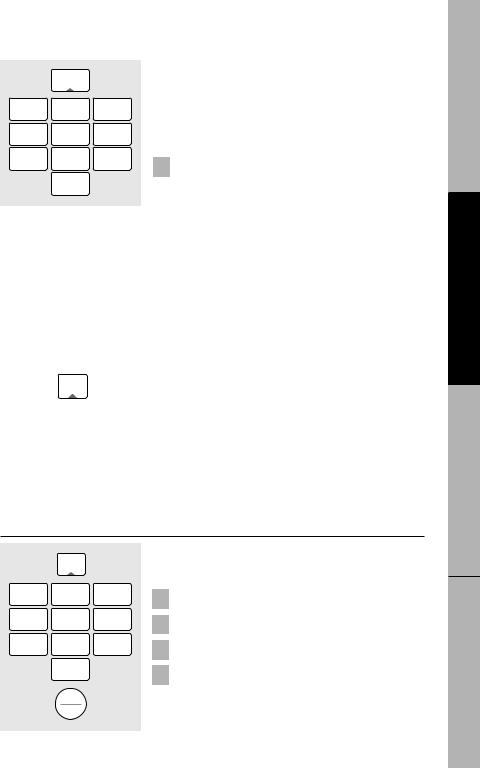
Other features your |
|
model may have. |
ge.com |
Custom |
|
CUSTOM
1 |
2 |
3 |
EXPRESS COOK |
EXPRESS COOK |
EXPRESS COOK |
4 |
5 |
6 |
EXPRESS COOK |
EXPRESS COOK |
EXPRESS COOK |
7 |
8 |
9 |
The CUSTOM pad allows you to save your most frequently used settings. (Sensor cooking settings cannot be saved.)
To set and save a setting:
1 Press the CUSTOM pad.
0 |
|
|
|
|
|
2 |
Set the amount of cooking time. |
||
|
|
|||
|
|
|
Set the power level, if desired. (Full power will |
|
|
|
3 |
||
|
|
automatically be set if you do not change it.) |
||
|
|
|
||
|
|
|
Press the CUSTOM pad. |
|
|
|
4 |
||
|
Your custom setting will be remembered for future |
|||
|
one touch use. |
|||
|
To clear the custom setting, press and hold the |
|||
|
CUSTOM pad for 2 seconds. |
|||
|
|
|||
|
Help |
|||
HELP |
||||
The HELP pad displays feature information and |
||||
|
||||
|
helpful hints. Press HELP; then select a feature pad. |
|||
|
||||
|
|
|||
|
Cooking Complete Reminder |
|||
|
To remind you that you have food in the oven, |
|||
|
the oven will display FOOD IS READY and beep once |
|||
|
a minute until you either open the oven door or |
|||
|
press CLEAR/OFF. |
|||
CLOCK
AM / PM
1 2 3
EXPRESS COOK EXPRESS COOK EXPRESS COOK
4 |
5 |
6 |
EXPRESS COOK EXPRESS COOK EXPRESS COOK
7 |
8 |
9 |
|
0 |
|
START
PAUSE
Clock
Press CLOCK to set the time of day.
1
2 Enter the time of day.
3
4 Press START.
To check the time of day while microwaving, press CLOCK.
Instructions Safety
Instructions Operating
Tips Troubleshooting
Support Consumer
25
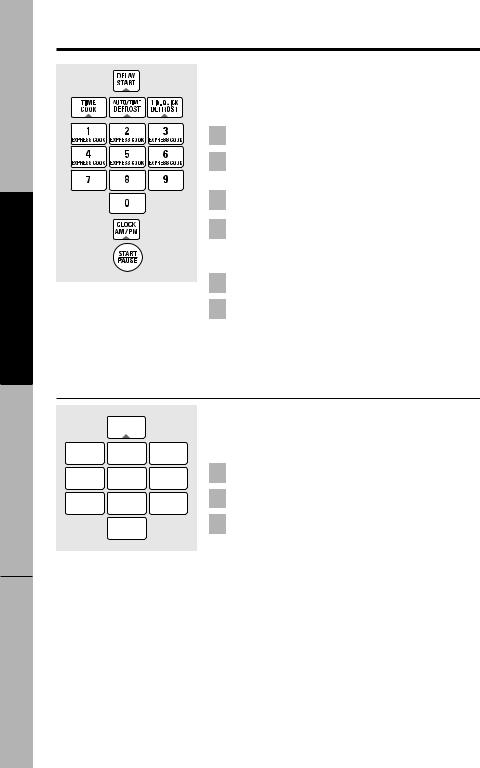
Safety Instructions
Operating Instructions
Troubleshooting Tips
Consumer Support
Other features your model may have.
Delay Start
Delay Start allows you to set the microwave to delay cooking up to 24 hours.
1 Press DELAY START.
2 Select the cooking or defrosting feature you wish to delay; then enter the cooking or defrosting time.
3 Press START.
4 Enter the time you want the oven to start.
(Be sure the microwave clock shows the correct time of day.)
5 Select AM or PM.
6 Press START.
The start time will be displayed and will remain until the oven automatically starts at the delayed time.
The time of day may be displayed by pressing CLOCK.
|
TIMER |
|
1 |
2 |
3 |
EXPRESS COOK EXPRESS COOK EXPRESS COOK
4 |
5 |
6 |
EXPRESS COOK EXPRESS COOK EXPRESS COOK
7 |
8 |
9 |
|
0 |
|
Timer
Timer operates as a minute timer and can be used at any time, even when the oven is operating.
1 Press TIMER.
2 Enter time you want to count down.
3 Press TIMER to start.
To pause the countdown, press TIMER.
When time is up, the oven will signal. To turn off the timer signal, press TIMER.
NOTE: The timer indicator will be lit while the timer is operating.
To cancel the timer, press and hold the TIMER pad for 2 seconds.
26
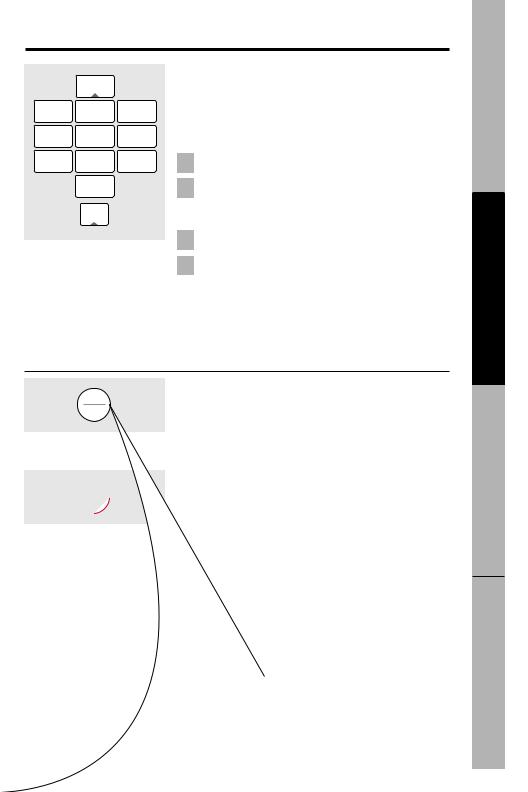
ge.com
REMINDER
1 |
2 |
3 |
EXPRESS COOK |
EXPRESS COOK |
EXPRESS COOK |
4 |
5 |
6 |
EXPRESS COOK |
EXPRESS COOK |
EXPRESS COOK |
7 |
8 |
9 |
|
0 |
|
CLOCK
AM / PM
Reminder
The Reminder feature can be used like an alarm clock, and can be used at any time, even when the oven is operating. The Reminder time can be set up to 24 hours later.
1 Press REMINDER.
2 Enter the time you want the oven to remind you. (Be sure the microwave clock shows the correct time of day.)
3 Select AM or PM.
4 Press REMINDER. When Reminder signal occurs, press REMINDER to turn it off. The Reminder time may be displayed by pressing REMINDER.
NOTE: The REM indicator will remain lit to show that the Reminder is set. To clear the Reminder before it occurs, press and hold the REMINDER pad for 2 seconds.
|
Start/Pause |
START |
In addition to starting many functions, |
PAUSE |
START/PAUSE allows you to stop cooking without opening the door or clearing the display.
Instructions Safety
Instructions Operating
Tips Troubleshooting
Support Consumer
27
